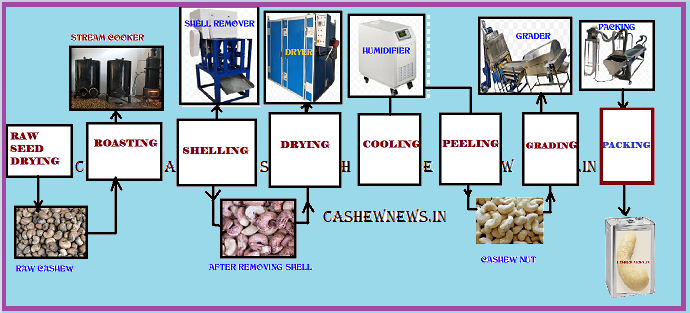Cashew Nut Processing
Cashew nuts are a valuable tropical crop, often referred to as “poor man’s crop, rich man’s food.” Originating in Brazil, they were introduced to India by Portuguese traders in the 16th century. Today, India is one of the world’s largest cashew producers and processors, with major operations in states like Kerala, Karnataka, Goa, Maharashtra, Tamil Nadu, Andhra Pradesh, Odisha, and West Bengal.

Processing Methods
There are two primary methods of cashew nut processing in India:
Roasting Process:
In this method, the nuts are roasted in a rotating drum, releasing thick black smoke, which can be a significant air pollutant. Despite its environmental drawbacks, this method is popular due to differences in nut flavor and a shortage of skilled workers for manual cutting.
Steam Cooking Process:
In this process, cashew seeds are cooked with steam to facilitate oil extraction from the shell. The extracted oil is valuable in industries like paint and adhesives. However, this process also generates air pollution, primarily from Baby Boilers used for steam generation and Borma heaters, and wastewater from steam quenching.
Environmental Concerns
The cashew industry, especially the smaller and cottage units, contributes to pollution through air emissions and wastewater discharge. The roasting method releases pollutants such as black smoke with an unpleasant odor, while the steam cooking method emits pollutants from boilers and heaters, alongside wastewater. Since most cashew processing units operate without effective pollution control systems, environmental pollution is a major concern, particularly in clusters of processing units.
Steps in Cashew Nut Processing:
Drying: Freshly harvested cashew seeds are dried for storage.
Soaking: Seeds are soaked to prepare them for further processing.
Cooking/Roasting: Depending on the method chosen, the seeds are either steam-cooked or roasted.
Shelling: The outer shell of the cashew is removed.
Separation: The cashew kernel is separated from the shell.
Kernel Drying: The extracted kernel is dried further.
Peeling: The thin skin covering the kernel is removed.
Packaging: The kernels are finally packaged for distribution.
In conclusion, while the cashew nut processing industry in India provides significant employment, especially in rural areas, it also poses environmental challenges. Therefore, more research and development into cost-effective, pollution-control measures are necessary for the long-term sustainability of the sector.
